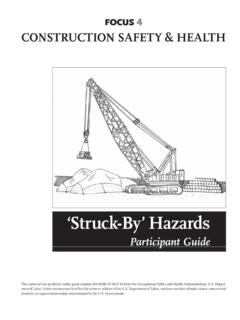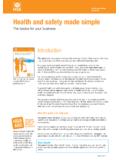Transcription of Preventing Slips, Trips, and Falls in Wholesale and Retail ...
1 DEPARTMENT OF HEALTH AND HUMAN SERVICES Centers for Disease Control and Prevention National Institute for Occupational Safety and HealthSummaryEmployees in Wholesale and Retail Trade (WRT) establishments suffer high rates of slip, trip, and fall (STF) injuries. The National Institute for Occupational Safety and Health (NIOSH) recommends measures to ensure a safe workplace and prevent 1. Spilled liquid on a floor that may cause Slips, Trips, and Falls in Wholesale and Retail Trade EstablishmentsDescription of the ProblemWRT includes employees engaged in wholesaling merchandise that is, pre-paring, distributing, and selling mer-chandise in Retail operations, and ser-vices related to those activities.
2 More than 21 million employees work in the Wholesale and Retail are the second most common cause of lost-workday injuries in general indus-try and can cause back injuries, sprains, strains, contusions, fractures, severe head injuries, paralysis, and even fatalities. STFs are the third most common cause of lost-workday injuries in WRT establish-ments. Seventy-five percent of the total STF injuries in WRT occur on the same level [BLS 2010; UWSP 2010]. Slips occur as a result of low friction between the shoe and walking surface; trips occur when a person s foot contacts an object or drops to a lower level; and Falls can result from either a slip or trip [UWSP 2010].
3 Among other risk factors, WRT em-ployees must frequently handle and move materials, putting them at high-er risk for STF injuries. Employees in Retail operations have a higher inci-dence rate of STF injuries than private industry employees overall. Employees in grocery stores and establishments where meat is handled are at particu-lar risk, with a 75% greater than average industry rate for all other private indus-tries combined ( vs. per 10,000 employees) [BLS 2010; Anderson and Mulhern 2010]. Risk Factors The following risk factors have caused slips, trips, and same-level Falls in the workplace [CDC 2011; NIOSH 2010; Anderson and Mulhern 2010; ISSA 2008; NFSI 2009; UWSP 2010]:Workplace Factors Spills on walking surfaces may cause slippery surfaces (See Figure 1).
4 Ice, snow, or rain can create out-door slipping hazards and can be tracked indoors. Loose mats or rugs may result in tripping. Boxes/containers may obstruct vi-sion (See Figure 2). Poor lighting affects visibility. Walking surfaces that are in disrepair, have protruding nails and boards, or changes in floor height may cause STFs. Contaminants on the floor, walking surface irregularities, and tripping hazards such as clutter, cords or hoses, on walking surfaces lead to most STF injuries in the Organization Factors Fast work pace can be a factor, as an employee might feel rushed and work at a faster than normal work pace, thus risking injury.
5 Work tasks that involve handling liquid or greasy materi-als may cause slippery Factors Age may affect balance, as the risk of same-level Falls in-creases with age. Employee fatigue may contribute to slips and trips. Failing eyesight/use of bifocals may prevent employees from seeing walking surfaces clearly. Inappropriate, loose, or poor-fitting footwear may cause a worker to trip. Smooth or worn soles may cause a worker to Standards provide guidance for maintaining safe walking and working surfaces (including stairs) and Preventing slip, trip, and fall hazards.
6 These include Occupational Safety and Health Adminis-tration (OSHA) regulation 29 CFR (a) and American Na-tional Standards Institute (ANSI) standards [2006, 2007]. The Na-tional Floor Safety Institute [2009] has issued an ANSI standard on testing procedures and devices to measure the wet static coefficient of friction of common hard-surface floor materials. A static coef-ficient of friction measures a surface s resistance to friction, or the friction between the shoe and the floor [OBWC ] Case StudiesSeveral case studies were provided by the Ohio Bureau of Workers Compensation: An employee was removing stacks of cardboard from a pallet.
7 As he picked up the cardboard, he stepped back and tripped over a pallet jack behind him (a pallet jack is used to lift and move pallets). He fell backwards, land-ing on his wrist, resulting in a fracture and missed work. A sales employee wearing sandals walked from the wet outdoors into the warehouse, slipped, and landed on an elbow, resulting in a sprained shoulder. An auto detailer slipped outdoors on the ice and fell on his head, suffering brain injury. RecommendationsMost STF incidents can be prevented with proper attention to the three categories of risk factors: workplace, work organization, and individual.
8 The following steps are recommended to prevent inju-ries related to slips, trips, and same-level and Workplace Design [NIOSH 2010; Anderson and Mulhern 2010; NCDOL 2010; ISSA 2008; OBWC] Develop a written STF prevention policy that specifies both employer and worker responsibilities. (See NIOSH 2010 for an example of developing an STF prevention plan.) Ensure that aisles and passageways are free of clutter and other tripping hazards. Provide proper lighting in all areas indoors and outdoors to reduce shadows, dark areas, and glare so that trip haz-ards or surface irregularities are clearly visible.
9 Replace burnt out light bulbs promptly. If electrical cords are used on a regular basis, install out-lets so that cords do not cross walkways. In grocery stores, ensure that water from produce spray mis-ters is directed onto produce, and is not spraying onto the floor. In grocery stores, provide customers with plastic bags and paper towels for wet produce to prevent it from dripping water onto the floor. Provide clean up supplies (paper towels, absorbent material, wet floor signs, etc) at convenient locations in the facility. Provide umbrella bags to prevent rain water from drip-ping onto the floor.
10 Select flooring material according to the work to be done in the area. Use flooring with a static coefficient of friction of more than for high-risk areas. A higher static coef-ficient of friction is safer and can be increased by wearing slip-resistant shoes and keeping floor surfaces clean and dry. Mats are used to provide slip-resistant walking surfaces by absorbing liquid and removing dirt, debris, and liquid from shoes. Provide water-absorbent mats near entrances and other areas where water, ice, or snow may drip or be tracked onto the floor.















